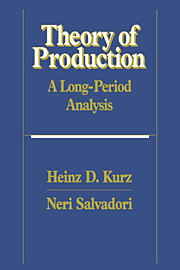Book contents
- Frontmatter
- Contents
- Preface
- A reader's guide
- 1 Free competition and long-period positions
- 2 A one-commodity model
- 3 Two-commodity models
- 4 Models with any number of commodities
- 5 Choice of technique
- 6 Alternative descriptions of a technique
- 7 Fixed capital
- 8 Joint production
- 9 Jointly utilized machines
- 10 Land
- 11 Persistent wage and profit rate differentials
- 12 On limits to the long-period method
- 13 Production as a circular flow and the concept of surplus
- 14 The neoclassical theory of distribution and the problem of capital
- 15 On some alternative theories of distribution
- Mathematical appendix
- References
- Name index
- Subject index
9 - Jointly utilized machines
Published online by Cambridge University Press: 06 January 2010
- Frontmatter
- Contents
- Preface
- A reader's guide
- 1 Free competition and long-period positions
- 2 A one-commodity model
- 3 Two-commodity models
- 4 Models with any number of commodities
- 5 Choice of technique
- 6 Alternative descriptions of a technique
- 7 Fixed capital
- 8 Joint production
- 9 Jointly utilized machines
- 10 Land
- 11 Persistent wage and profit rate differentials
- 12 On limits to the long-period method
- 13 Production as a circular flow and the concept of surplus
- 14 The neoclassical theory of distribution and the problem of capital
- 15 On some alternative theories of distribution
- Mathematical appendix
- References
- Name index
- Subject index
Summary
In Chapter 7 fixed capital has been introduced as a special form of joint production which has been investigated even before introducing general joint production models. In that chapter, however, only a special form of fixed capital was dealt with: only a single old machine was allowed for in each process and these machines were assumed as being ordered in the sense that each has an unambiguous age. It has also been shown that this form of fixed capital is compatible with the joint utilization of new machines. The present chapter is devoted to an analysis of more general fixed capital models. Specifically, old machines will be allowed to be used jointly. Only one assumption still needs to hold: machines cannot be transferred from one sector to another, that is, an oven once utilized to produce bread cannot be used during its lifetime to produce biscuits. On this assumption a number of “desirable” properties will be shown to hold. Among these properties there is the fact that consumption patterns do not matter at all in determining prices or operated processes, whereas the growth rate can play a role in determining the cost-minimizing technique and, therefore, prices.
From a formal point of view, the chapter provides some axiomatic definitions of fixed capital technologies and some theorems exploring these concepts. Definitions are introduced by assuming the possibility of partitioning the set of commodities and the set of processes in order to satisfy certain properties.
- Type
- Chapter
- Information
- Theory of ProductionA Long-Period Analysis, pp. 250 - 276Publisher: Cambridge University PressPrint publication year: 1995



